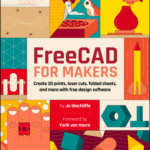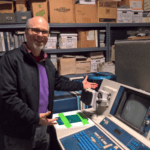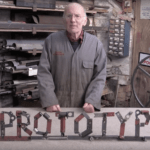HackSpace magazine’s Andrew Gregory chatted to Joel Gomes, the maker behind the Integza YouTube channel, for the latest issue of HackSpace magazine.
Many a home tinkerer has taken inspiration from Nikola Tesla, the brilliant engineer and scientist claimed by Austria, Hungary, Serbia, and Croatia. Not many, however, have taken it upon themselves to recreate his inventions using modern methods to entertain the YouTube generation. One who has (OK, the only one who has, to our knowledge) is Joel Gomes, aka Integza. He’s an unstoppable source of detonations and deflagrations and, thanks to him, we now know the difference between the two. He’s bringing the technology of the 1920s into the time of 3D printing, and we absolutely love it.

Hackspace: Good morning Joel! We can’t help but notice that there are two engineers in your videos: yourself and Nikola Tesla, who’s always looking over your shoulder. What’s so good about this Tesla chap?
Joel Gomes: I guess it’s because he’s one of the few inventors who was pure of heart. And, at the same time, he was able to combine being very smart with being very creative, which you don’t see a lot of. It’s rare: sometimes you see amazing engineers who are capable of solving insanely hard problems. But it’s really hard to find someone who can do that, but at the same time is extremely creative, in terms of getting stuff to work in a very beautiful way.
That was the thing that made me love the way he worked. Also, the fact that he was not really after money. He just wanted to see things come to life, which is basically what every single maker wants to do.

HS: Didn’t he figure out a way to transmit energy for free, but in such a way that it was impossible to charge money for it?
JG: I’m actually making a video on his life, and I’ve been in contact with some historians. There are some amazing stories about Nikola Tesla.
The wireless energy thing – it all started with a very rich guy in the US who wanted to bet on horses in the UK. But he couldn’t do it because you can’t really stretch a landline from the UK all the way to the US. So, he needed some wireless way of communicating, which eventually became radio. Nikola Tesla started working on the radio, and I think he solved the problem in two months.
The thing is, if someone tells you, “I’m gonna give you a lot of money. Take your time doing this. And while you take your time, I’m gonna give you more money,” that changes your incentives.
So he was like, OK, I solved the problem. But I can take this a step further. So, he wanted to go from wireless communication to wireless energy. So he kept on going.
One of the things that he did while he was trying to get there was to build a radio-controlled boat. And he showed it to a bunch of rich people. And up until recently, nobody knew if this was a real story. But Cameron Prince, who is one of the historians that I talked to, has a letter that proves it. Because his assistant sent him a letter saying, “The boat is here. I got it. Don’t worry, Nikola. Everything’s fine.”
Anyway, he developed all of that. Somehow, Marconi got the idea of reading his patents. And he realised, if he put like seven patents together, you could build a radio. He kind of pulled the rug out from under Tesla. He got the radio first, and once Tesla’s sponsor knew that the radio was out there, he was like, “Oh, I don’t need you any more, I’m not giving you any more money.”

HS: It’s a silly question maybe, but do you think Tesla would have liked 3D printing?
JG: Probably. I’ve read three or four patents of his, and I’ve met some people who know them by heart, and you can tell by the way he writes his patents that he looks at everything like a tool. So he doesn’t have sentimental attachment to technologies. He just looks at everything like a tool, like a car is a tool to get you from point A to point B. And, for him, a 3D printer would be a tool just to get stuff done that is really hard to do any other way.
HS: The reason I ask is that you’ve recreated lots of Tesla’s inventions – I think the first one was the Tesla turbine, which I guess would have been much easier for you to make than it was for him to make 100 years ago.
JG: But the thing is, I didn’t use 3D printers because that was the best way to do it, because it’s not. I used them because I have no skills whatsoever with my hands. The only thing that I know how to do is 3D modelling. I can actually brag a little bit and say that, I’m pretty good at that.
But then again, 3D modelling is just like a virtual model; you can’t put it into the physical world, at least until I found out that 3D printing was a thing. And then I was like, “Oh, I need to get one of these! I don’t know how to weld properly; I don’t know how to machine properly”… 3D printing was the one thing that allowed me to become a maker.

HS: You mentioned in one of your videos that you’ve been using SOLIDWORKS since you were at college? Did you do any engineering at college?
JG: Yeah, I studied mechanical engineering for five years. Then I worked as a mechanical engineer for four years. And, in between, I started my YouTube channel.

HS: You’re obviously interested in the history of science as well?
JG: I get lost on Wikipedia. I have an idea, I look for it, I’m reading Wikipedia… and then Wikipedia is like a wormhole. You start reading, oh, but what is this? What is this about? And you click a link, and another link, and another link, and somehow you get this amazing story that I just have to make a video about.
I do care a lot about the history part of it. I love history, especially when it’s about technology and inventions, and amazing people that did amazing stuff.
HS: I think that’s why your videos work, because they are personal.
JG: They are personal. I can’t really make a video about something that I don’t care about. Sometimes you see other YouTubers making videos, and they’re getting a lot of views. But I can’t make a video about it, because I don’t really care about it. Like, it’s not a subject that matters to me. And I know if I make a video about it, it’s going to be shallow, very, very shallow.
The only way to actually make a project that works is to care about it. So I try to keep myself on that side of the line.

HS: Your most recent video on YouTube is the liquid piston engine. Do you have any involvement in that project’s development?
JG: No, I’m just a fan. I’m just a fan that happens to be a YouTuber, and was able to talk with them to go there and try it out. I’ve been a fan of the project for a while. But, of course, sometimes you send an email and nobody responds. This time, they actually responded. But it was amazing, because I could actually go there and see the engine. They talked to me about the how it works, exactly how they had the idea. And that’s my cup of tea. Amazing.
We ran it on vodka, which was insane. So yeah, it was a pretty good experience. But no, I’m not involved in any way, shape, or form.
HS: Vodka?
JG: It was just like a silly experiment. The CEO was bragging about the fact that that engine can run on almost any kind of fuel, and I was like, does it run on ethanol? And he was like, yeah. We only had to recalculate the jet for the carburettor, and it worked, first try.

HS: What made you start your YouTube channel?
JG: I wanted to do a YouTube channel for a long time. Because, before I was a YouTuber, I was someone who consumed YouTube. And I still do. And anyone who consumes media would one day like to produce it too.
Also, I always loved videography. In 2015 or ’16 I finished college, and I wanted to give it a go before I had to start a serious job where I wouldn’t have time to do it.
I sucked at it, because I had no background with videography. So, I had to learn everything from scratch – again, using YouTube. Eventually I was able to put out a video that was decent, because I think my first, like, ten videos were just rubbish, just a horrible, horrible learning experience.
That’s the first thing that I say to everyone who is a maker and wants to become a YouTuber. Like, there’s no way you’re going to do it if you don’t like videography, because it’s a very big part of it. Some people think that to become a maker on YouTube, you just make stuff and you put a camera in front of it. No: you need to like it, because if you don’t, it’s just going to be very, very annoying. A task as simple as removing a piece of support material from a 3D-printed part normally would take you, like, 30 seconds; when you have to record it, it takes you, like, ten minutes.

HS: But you weren’t making things at first; you were talking about what happened to make you shift from just talking about science subjects to making things in front of the camera?
JG: I wanted to start making stuff right off the bat. But, like I told you, I didn’t have any skills, because I was an engineer. We’re good at designing, but not so good at making.
I was a broke college kid, so I didn’t have any money. And a Chinese company contacted me, and they were like, “Oh, would you mind reviewing our printer? We’ll send it for free and you can review it.” And I was like, “Yeah, wait, are you sending me a printer for free? Oh my God, thank you!”
I got addicted to 3D printing immediately. And the first thing that came to mind was the Tesla turbine. That was my first video that went viral. And when I say viral, I got like 100,000 views which, for me, was insane. That’s how I got started. And then it took me a while to find my place on YouTube. Like, I’m the 3D printing jet engine Nikola Tesla guy. It took me a while to find it. But now I’m here.

HS: Do you have a bit of competition from Colin Furze in the jet engine area?
JG: I don’t have competition because I love that guy!
I started YouTube because of him. I remember being in college and watching his videos. I was with him in San Francisco and he told me that his first camera was a Super 8 video camera.
That’s crazy: I thought it was a GoPro. That’s how long he’s been on YouTube. I think he started his channel in 2006 – YouTube only started in 2005. And I’ve been watching him since forever. And he kind of has that same vibe that I do, in the sense that you can do it. Right?
It doesn’t matter how hard it seems or how complicated. A turbojet engine? You can do it. You can do it with a roll of toilet paper and a turbocharger from a car. Just put it together with tape and it works. And I think that that is the vibe that I always tried to mimic, that everyone can do it.

HS: And you’re both obviously having a lot of fun?
JG: That’s the thing about it. It can become a little bit dangerous sometimes. And especially for him. I think I’m like a lightweight. There was actually a panel at Open Sauce, talking about dangerous people. And I didn’t even make the panel because it filled up before I could attend the panel. I think it was Colin Furze, Styropyro, ElectroBOOM, The Backyard Scientist, and someone else.
But anyway, there were a lot of dangerous YouTubers there. There’s an old video by Colin Furze in which he literally burns his entire arm. And he vlogs it because he goes to the hospital and he’s like popping the blisters on his burns. Nowadays he doesn’t really get hurt. As much.
HS: OK, so if you were starting out today building your first jet engine, where would you start?
JG: I would use metal because now I know enough about welding that it becomes much easier to make, for example, a pulse jet engine, with sheet steel.
At the time, I didn’t know how to weld, so I decided to go another way. I found this Swedish YouTuber who developed this way of using carbon fibre and this weird refractory plaster that can take high temperatures. And he basically used 3D printing in that to make a pulse jet. And I was like, “That’s my vibe; I can make it happen even without knowing how to weld”. In that case, I did it; I just used the same method.
Nowadays, if I could do it again, I would use welding and sheet steel metal. But what I really want to do now is do a turbojet engine that is 100% metal 3D printed. A lot of people don’t know about this, but metal 3D printing just became very affordable. Not the machine itself, but the service, so you can get metal parts 3D printed really cheap.
The first thing I tried to get printed was a wrench ring – a little spanner that’s shaped to go around your finger like a ring. And that cost me $5. The sky’s the limit now. I can do whatever I want.

HS: Have you tried metal 3D printing for more functional parts?
JG: I made a jet engine based on a Dyson hairdryer.
It felt like cheating. Normally when you make a jet engine, there’s a lot involved.
What I did for combustion chambers a while ago was spot-welding, which is hard. It literally takes forever just to [make] the combustion chambers. And, with metal 3D printing, I literally just 3D-modelled it. I sent it to the company, and then it was done. It arrived back here, I assembled it, injected some hydrogen into it, and it was working.
OK, I’m lying. I had to do the injection system. But that’s not that hard.
That’s the thing with metal 3D printing. It makes stuff that ordinarily would be impossible to make by hand so easy. The machine does all the work, and we just need to enjoy the flames.
I got so much hate for that video, because I bought three Dyson hairdryers, and I destroyed two.
When I bought the hairdryers, it was around Mother’s Day, and the girls in the shop were impressed, because they thought I was buying them for my mother or my sisters, or something like that. I was like, no, I’m gonna destroy them all.
They wanted to punch me in the face for that but, for me, it was like buying lumber. It was like something that I needed for the video.
And I remember when I was younger, I would love to break stuff apart to see how it worked. And my mother told me, you know, you’re never gonna get a job destroying stuff.
I used to remove the motors from RC cars to make RC boats. Now, I basically destroy hairdryers to make a jet engine. So, it’s almost the same thing.
HS: Do you have a favourite among your projects?
JG: I think it would be the pulse jet, because the day I made the video was the first time I’d managed to get it to run. I was so happy, and you can tell on the video. I can’t even hide it properly. I’d been trying to make my own pulse jet engine for like nine months, I failed and I failed. And I failed. Because starting a pulse jet engine, especially the valveless ones, is a form of art: you have to give it a little bit of compressed air, a little bit of butane… you hear that rumbling start to build up. And you have to give it more air and a little more butane until it starts and you can remove the air and it works just with the fuel source. It was so hard.
It’s funny because I talked about this with Colin Furze, and he says exactly the same thing. It looks very easy on camera, but it’s so hard. I built the engine the night before and woke up early on Saturday because I was really anxious to see it working. Thank God the camera was rolling. I was ecstatic. It was super-loud. My family all woke up. My mother was concerned because she thought I had killed myself. No other project has me so happy, because it was the first time I made a jet engine with my own hands, and using 3D printers.
HS: What is it about jet engines that you think has captured your imagination?
JG: There’s a little bit of alchemy there too… you’re taking a little bit of this chaos around you, and funnelling it into defying entropy. Jet engines are a very unnatural thing. When you look at them, you can tell that they are not supposed to exist in nature. But it’s funny because in our core, we can’t really explain or justify the things we like, or don’t like. So I can’t justify why I like jet engines so much. I think it’s the raw power of it. Even more so rocket engines, because it’s just, it’s raw power, it’s just flames and thrust. It’s insane, it’s scary, and I love them.
HackSpace magazine issue 70 out NOW!
Each month, HackSpace magazine brings you the best projects, tips, tricks and tutorials from the makersphere. You can get HackSpace from the Raspberry Pi Press online store or your local newsagents.









